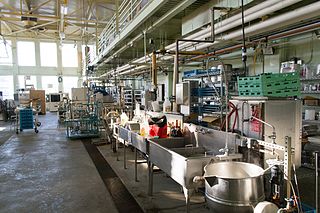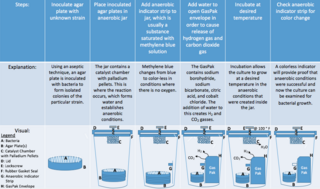Instruments used specially in microbiology include: [1] [2]
Instruments used specially in microbiology include: [1] [2]
| Instrument | Uses |
|---|---|
| Autoclave | used for sterilization of glass ware and media |
| Auto-destruct syringes | specimen collection |
| Bijou bottle | a cylindrical small glass bottle with a screw cap used as a culture medium holder |
| Biosafety cabinet | used to work with dangerous organisms and to work sterile |
| Blood collection bottle | to collect blood by venipuncture |
| Brittany | a process of sterilization from spore-bearing bacteria |
| Bunsen burner | used to work aseptic on the benc |
| Candle jar | historically used for anaerobiosis; a lit candle was placed in as air-tight jar such that when it went out it would be because it used up all the available oxygen |
| Castaneda's medium / Castaneda's bottle | used for simultaneous solid and liquid cultures in many bottles |
| Centrifuge | to separate supernatant & pellet |
| Cragie tube | see link |
| Desiccator | to dry things |
| Durham's tube | used to detect gas production in sugar fermentation media; the tube is placed in an inverted fashion so that gases produced get trapped in it and do not float away to the surface |
| Gas-pak | releases gases to remove oxygen from a closed container, usually for anaerobiosis |
| Glass slide | used to observe specimens under microscope |
| Haemagglutination plate | for viral culture detection |
| Hungate Anaerobic tubes | for culturing of anaerobic microbes |
| Incubator | used for bacterial or fungal cultures |
| Inoculation loop: | used to inoculate test samples into culture media for bacterial or fungal cultures, antibiograms, etc. Sterilized by passing through a blue flame. |
| Laminar flow cabinet | used to work aseptic |
| Latex agglutination tiles | for serological analysis |
| Lovibond comparator | a type of a colorimeter |
| McCartney's bottle or Flat medical bottle | for simultaneous solid and liquid cultures. |
| McIntosh and Filde's anaerobic jar | production of anaerobic conditions for organisms that die in the presence of even little oxygen (anaerobiosis), e.g. tetanus bacteria |
| Microscope | to observe microscopic specimens that cannot be seen by the naked eye. |
| Microtitre plates | mostly used for ELISA |
| Microtome | cuts prepared specimens for analysis under microscope |
| Nichrome wire loop | used to inoculate test samples into culture media for bacterial or fungal cultures, antibiograms, etc.; sterilized by flaming to red hot before use |
| Petri dish/agar plate | to act as a supporting container to hold the culture medium in |
| Platinum wire loop | used to inoculate test samples into culture media for bacterial or fungal cultures, antibiograms, etc.; sterilized by flaming to red hot before use |
| Pre-sterilized disposable container | specimen collection |
| Pre-sterilized disposable swabs / NIH swab / postnasal swab | specimen collection |
| Pre-sterilized disposable syringe / auto-destruct syringes | specimen collection |
| Roux culture bottle | Bottle designed to use laying flat, useful for growing mass cultures and single or monolayer cultures. |
| Serological test slides like those for ASO, VDRL, rheumatoid factor | provide links |
| Specimen Dish | used to hold specimen or samples |
| Sterile loops | used to inoculate test samples into culture media for bacterial or fungal cultures, antibiograms, etc.; not heated before use—these are disposable pre-sterilised |
| Thermal cycler | used to amplify segments of DNA via the polymerase chain reaction (PCR) process. |
| Tissue culture bottles | to grow or keep alive cells or tissue from a living organism, e.g. stem cells |
| Tuberculin syringe | as a normal syringe or to perform Mantoux test |
| ULT freezer | to freeze and storage of specimens |
| Universal container | a cylindrical small glass bottle with a screw cap used as a culture medium holder |
| Vaccine bath | used to heat vaccine containing medium gently to around 45-55 degrees Celsius during vaccine production |
| Vacuum pump | to draw out the air from any closed chamber before pumping back CO2, O2 or N2, usually for anaerobiosis |
| VDRL rotator | for VDRL test |
| (Laboratory) Water bath | to incubate specimens or samples |
As well as those "used in microbiological sterilization and disinfection" (see relevant section).

A microorganism, or microbe, is an organism of microscopic size, which may exist in its single-celled form or as a colony of cells.

Food science is the basic science and applied science of food; its scope starts at overlap with agricultural science and nutritional science and leads through the scientific aspects of food safety and food processing, informing the development of food technology.

A growth medium or culture medium is a solid, liquid, or semi-solid designed to support the growth of a population of microorganisms or cells via the process of cell proliferation or small plants like the moss Physcomitrella patens. Different types of media are used for growing different types of cells.
Inspissation is the process of thickening by dehydration.

Hot air ovens are electrical devices which use dry heat to sterilize. They were originally developed by Louis Pasteur. Generally, they use a thermostat to control the temperature. Their double walled insulation keeps the heat in and conserves energy, the inner layer being a poor conductor and outer layer being metallic. There is also an air filled space in between to aid insulation. An air circulating fan helps in uniform distribution of the heat. These are fitted with the adjustable wire mesh plated trays or aluminium trays and may have an on/off rocker switch, as well as indicators and controls for temperature and holding time. The capacities of these ovens vary. Power supply needs vary from country to country, depending on the voltage and frequency (hertz) used. Temperature sensitive tapes or biological indicators using bacterial spores can be used as controls, to test for the efficacy of the device during use.
Dry heat sterilization of an object is one of the earliest forms of sterilization practiced. It uses hot air that is either free from water vapor or has very little of it, where this moisture plays a minimal or no role in the process of sterilization.
Moist heat sterilization describes sterilization techniques that use hot water vapor as a sterilizing agent. Heating an article is one of the earliest forms of sterilization practiced. The various procedures used to perform moist heat sterilization process cause destruction of micro-organisms by denaturation of macromolecules.

Gas-pak is a method used in the production of an anaerobic environment. It is used to culture bacteria which die or fail to grow in the presence of oxygen (anaerobes).
The Cragie tube or Craigie tube is a method used in microbiology for determining bacterial motility.

A Berkefeld filter is a water filter made of diatomaceous earth (Kieselguhr). It was invented in Germany in 1891, and by 1922 was being marketed in the United Kingdom by the Berkefeld Filter Co. Berkefeld was the name of the owner of the mine in Hanover, Germany, where the ceramic material was obtained.

A Chamberland filter, also known as a Pasteur–Chamberland filter, is a porcelain water filter invented by Charles Chamberland in 1884. It was developed after Henry Doulton's ceramic water filter of 1827. It is similar to the Berkefeld filter in principle.
McIntosh and Filde's anaerobic jar is an instrument used in the production of an anaerobic environment. This method of anaerobiosis as others is used to culture bacteria which die or fail to grow in presence of oxygen (anaerobes).
Complement 2 deficiency is a type of complement deficiency caused by any one of several different alterations in the structure of complement component 2.
A nucleic acid inhibitor is a type of antibacterial that acts by inhibiting the production of nucleic acids. There are two major classes: DNA inhibitors and RNA inhibitors. The antifungal flucytosine acts in a similar manner.

Microbiology is the scientific study of microorganisms, those being unicellular, multicellular, or acellular. Microbiology encompasses numerous sub-disciplines including virology, bacteriology, protistology, mycology, immunology, and parasitology.
Complement 4 deficiency is a genetic condition affecting complement component 4.
R. Ananthanarayan Ph.D. was an Indian microbiologist. He graduated from Madras Medical College in 1941 and joined the Army Medical Corps during the Second World War. He joined Stanley Medical College, Madras in 1946 and developed an interest in influenza. He obtained his Ph.D. from the London School of Hygiene & Tropical Medicine in 1953 with a thesis on "The Fabric of the Influenza virus". He became professor of bacteriology at Trivandrum Medical College. He was a member of the team set up to monitor the Asian Flu Pandemic in 1957–58. He served as principal of Calicut Medical College from 1961 to 1967 and subsequently of Kottayam Medical College. After retirement in 1969, he was professor of microbiology at Mahadevappa Rampure Medical College, Kalburgi. Ananthanarayan was president of the Indian Association of Pathologists and Microbiologists (1976) and the Kerala State branch of the Indian Medical Association. His work on "A. Asia 57" was recognized by the World Health Organization. He wrote a Textbook of Microbiology in collaboration with C. K. Jayaram Panicker, of which ten editions have been published.

An inoculation needle is a laboratory equipment used in the field of microbiology to transfer and inoculate living microorganisms. It is one of the most commonly implicated biological laboratory tools and can be disposable or re-usable. A standard reusable inoculation needle is made from nichrome or platinum wire affixed to a metallic handle. A disposable inoculation needle is often made from plastic resin. The base of the needle is dulled, resulting in a blunted end.

In microbiology, colonial morphology refers to the visual appearance of bacterial or fungal colonies on an agar plate. Examining colonial morphology is the first step in the identification of an unknown microbe. The systematic assessment of the colonies' appearance, focusing on aspects like size, shape, colour, opacity, and consistency, provides clues to the identity of the organism, allowing microbiologists to select appropriate tests to provide a definitive identification.